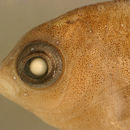Diagnostic Description
(
Inglês
)
fornecido por Fishbase
Adults brownish gray with a yellowish cast; vertical dark lines following scale rows; a large blackish spot covering most of pectoral base, darkest near upper part; pectorals slightly dusky. The young are bright yellow with a large black spot at base of dorsal fin at junction of spinous and soft portions, a large black spot dorsally on caudal peduncle and a small one at upper pectoral base (Ref. 13442).
- licença
- cc-by-nc
- direitos autorais
- FishBase
Life Cycle
(
Inglês
)
fornecido por Fishbase
Oviparous, distinct pairing during breeding (Ref. 205). Eggs are demersal and adhere to the substrate (Ref. 205). Males guard and aerate the eggs (Ref. 205).
- licença
- cc-by-nc
- direitos autorais
- FishBase
Morphology
(
Inglês
)
fornecido por Fishbase
Dorsal spines (total): 12; Dorsal soft rays (total): 15 - 17; Analspines: 2; Analsoft rays: 13 - 14
- licença
- cc-by-nc
- direitos autorais
- FishBase
Trophic Strategy
(
Inglês
)
fornecido por Fishbase
Inhabits inshore and offshore coral reefs. Found within caves at night (Ref. 9626). Often found in tangles of staghorn coral; anywhere there is abundant algae on reefs (Ref. 26938). Feeds mainly on algae but also on harpacticoid copepods, small gastropods, eggs of mollusks, sponges, polychaetes and hydroids (Ref. 9626); also feeds on detritus, plants and other benthic organisms (Ref. 33). Juveniles subsist on the external parasites of fishes (Ref. 5521). Pugnaciously guards large territories, will chase and nip intruders of all sizes, including divers (Ref. 9710). Territorial herbivore (Ref. 57616).
- licença
- cc-by-nc
- direitos autorais
- FishBase
Biology
(
Inglês
)
fornecido por Fishbase
Adults inhabit inshore and offshore coral reefs. They are found within caves at night (Ref. 9626). Often found in tangles of staghorn coral; anywhere there is abundant algae on reefs (Ref. 26938). Feed mainly on algae but also on harpacticoid copepods, small gastropods, eggs of mollusks, sponges, polychaetes and hydroids (Ref. 9626). Juveniles subsist on the external parasites of fishes (Ref. 5521). Adults pugnaciously guard large territories, will chase and nip intruders of all sizes, including divers (Ref. 9710). Oviparous, distinct pairing during breeding (Ref. 205). Eggs are demersal and adhere to the substrate (Ref. 205). Males guard and aerate the eggs (Ref. 205). Taken incidentally in traps and small-meshed beach nets (Ref. 5217).
- licença
- cc-by-nc
- direitos autorais
- FishBase
Importance
(
Inglês
)
fornecido por Fishbase
aquarium: commercial
- licença
- cc-by-nc
- direitos autorais
- FishBase

